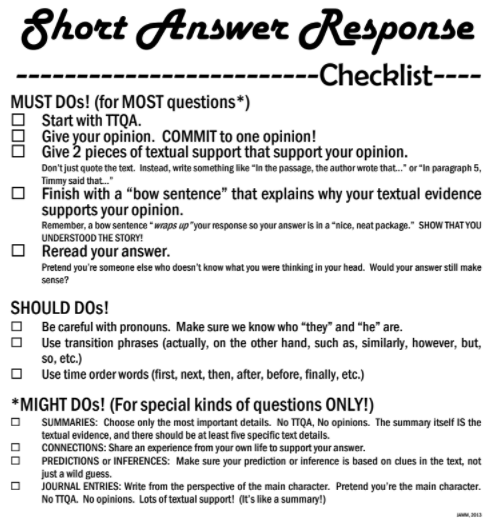Viewing: Class Updates
January 7, 2018
Supporting Students’ Choices
Hello, families! One of my focuses this year has been helping students to make the best possible choices in class. As a group, we’ve been working to curtail side conversations, increase direction following, and improve the amount of respect in the classroom. In early December, I launched some new approaches, and I’m so happy to say that these have been very helpful in making our classroom a more focused, kind, and positive space for learning. These new approaches include three parts:
Our Goals
Like every other class at PGS, we have a social contract that outlines how students and teachers want to be treated by one other. While it has many important qualities included in it, I found that it lacked the specificity needed to give us precise goals. For example, the idea of respect was included in our social contract, but it didn’t outline what respect is, what it looks like, how it makes us feel, etc. So, through some discussions with students, I developed a new set of goals for our class. Before you look at it, let me warn you: It looks like a lot. But in fact, it’s not as complicated as it seems.
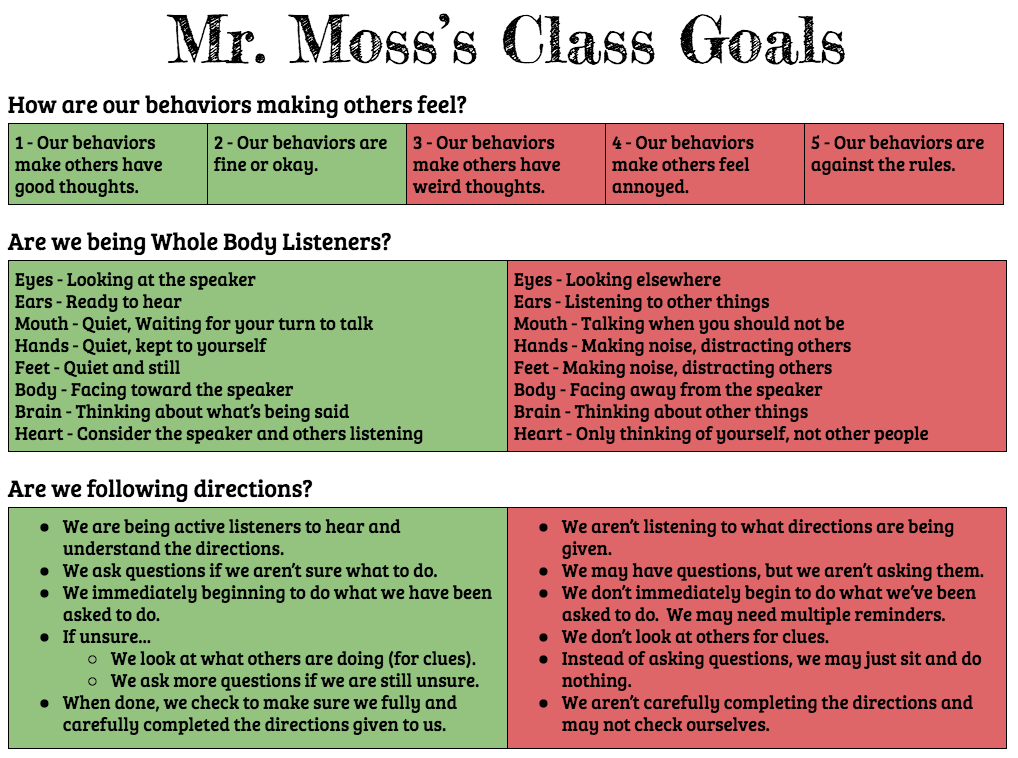 Our new class goals, pictured left, focus on three different areas of our social contract that we (as a group) felt were challenges: respect, focus, and in-control. Using those areas as starting points, we discussed what those qualities looked like and felt like. For “How are our behaviors making others feel?” we use a rating scale that has been very helpful to us throughout the year. Rather than rating the behaviors themselves, this scale focuses on how others feel about our behaviors. Students are VERY familiar with this and can quickly identify whether a behavior is desirable (leading to a 1 or 2 feeling in others) or undesirable (resulting in a 3, 4, or 5 feeling in others). This rating scale came from the game “Should I or Shouldn’t It?”, by Social Thinking, which poses social situations that students must respond to. Some are black and white, like feeling hungry, and taking a snack off a friend’s desk. (A 4 or 5 for sure!) But others are quite a bit more gray, like hearing the doorbell ring and opening the door on your own because your mom didn’t hear it in the other room. (Is it a 1 or 2 because you helped your mom by answering the door? Is it a 5 because you aren’t allowed to open the door? Somewhere in between?)
Our new class goals, pictured left, focus on three different areas of our social contract that we (as a group) felt were challenges: respect, focus, and in-control. Using those areas as starting points, we discussed what those qualities looked like and felt like. For “How are our behaviors making others feel?” we use a rating scale that has been very helpful to us throughout the year. Rather than rating the behaviors themselves, this scale focuses on how others feel about our behaviors. Students are VERY familiar with this and can quickly identify whether a behavior is desirable (leading to a 1 or 2 feeling in others) or undesirable (resulting in a 3, 4, or 5 feeling in others). This rating scale came from the game “Should I or Shouldn’t It?”, by Social Thinking, which poses social situations that students must respond to. Some are black and white, like feeling hungry, and taking a snack off a friend’s desk. (A 4 or 5 for sure!) But others are quite a bit more gray, like hearing the doorbell ring and opening the door on your own because your mom didn’t hear it in the other room. (Is it a 1 or 2 because you helped your mom by answering the door? Is it a 5 because you aren’t allowed to open the door? Somewhere in between?)
The second goal focuses on whole body listening. While that may sound silly to you, it’s helpful in showing students exactly what’s expected of them. (We have a dandy poster in class that lists these qualities in a more visually clear, approachable manner.) Finally, the third goal focuses on following directions, which should be self-explanatory.
So while you may look at these goals and find yourself taken aback by all the wording, please understand that these ideas are very familiar to students, and they typically don’t NEED to review the detailed language. Unified arts teachers have reported to me that their times with our class have also improved since we started using these goals. (They all have their own copies to use with our students.)
At the end of an activity, we reflect on how the activity went. We discuss the choices students made (as a group) and how everyone felt based on the behaviors of those around them. (Again, this may sound a bit cheesy, but it’s working!) If we agree that the class fell into the green zone for all three questions, the class earns a point.
Points
Small goals help students to see the success of their choices on a more consistent basis. When we started this, we identified the number of opportunities students have on a given day to earn points, and we estimated that the class can potentially earn as many as eight or nine points on a given day. So, to start, we set a goal of 25 points for earning a pajama day! Little did I know how quickly we’d reach our goal, and the kids earned their points right near our school-organized pajama day fundraiser for CCMC. So we switched to popsicles. (I confess, I’ve been dragging my heels on this. It took me a few days to get the popsicles, and then after being out for a death in the family, vacation, and the snow days, we haven’t yet gotten to enjoy the treats. This week for sure!) Now, students are working to earn 50 points for a movie opportunity! The speed at which the class earns points has slowed a bit as the novelty has worn off (and that’s entirely typical), but we’re getting there!
Blurt Blocks
Our class is a community, and in that spirit, I like to focus on class successes. That’s why the group earns points for overall success. But I recognize that it’s important for students to be individually accountable as well. I continue to offer chance tickets to students who are making admirable choices in class, but I added in something new to support students when they’re not making appropriate choices: Blurt Blocks. If a student isn’t acting appropriately in class, I give him or her a Blurt Block. They’re little plastic blocks, and if a student receives a Blurt Block, they have to hold them in their hand (or keep them close by, if they need their hands for a learning activity). These aren’t intended to be an embarrassment for students. Rather, they serve as a tangible reminder that the student needs to change his or her behavior. If a student receives two Blurt Blocks during a single activity, he or she completed a letter home to his/her parent(s) about what happened and what needs to improve. That letter must be signed and returned to school the next day. At the end of an activity, when we look at whether we met our goals, students return any Blurt Blocks they received and start fresh for the next activity.
Overall, these three new approaches have been very helpful in improving our class environment. The overall mood in the classroom is more peaceful and focused, and we’ve been much more productive in recent weeks.
If you have any questions about our new approaches, please feel free to contact me.
Posted in Class Updates|By Jon Moss
November 9, 2017
How Written Responses are Assessed
With report cards coming home in about a week, I wanted to take a moment to encourage you to visit your child’s Google Classroom page. You’ll need to login with his or her username and password, but the students know that she should always be willing to share their login information with their parents/guardians. On our Google Classroom page, you’ll find much of your child’s written work, including responses to text (check out “A Chair for My Mother SAR”) and descriptive writing (look for the “Summer Snapshot” writing) projects. Feel free to look around, but PLEASE allow your child to do his or her work at school, and please resist the strong urge (Hey, I get it!) to help your child to improve the works-in-progress you see (since I won’t know what’s your child’s work and what is your work).
While not all the documents you’ll come across are intended to be graded (as some are planning tools for other purposes, others are collaborative practice, etc.), those tasks that are assessed are graded within the document itself. Any grades and comments are written in yellow text, highlighted in black. Bold as that is, it clearly distinguishes my work from your child’s work. (Think of that color pattern as my trademark “teacher’s red pen”, if you will.)
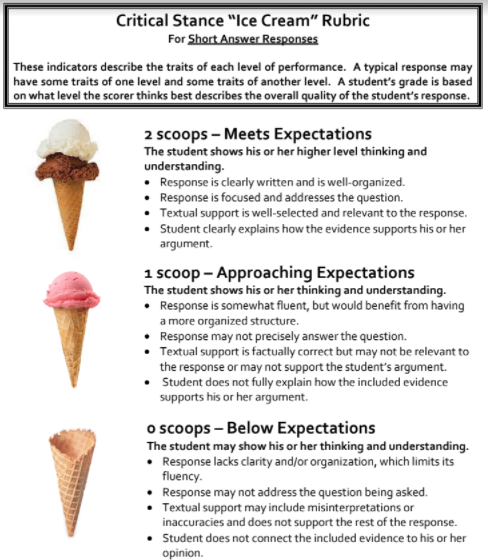 Short answer responses are most typically assessed on a 0-1-2 point scale. Here is a copy of the rubric we use. I want to stress that 0, 1, and 2 should not be converted into a percentage. That is, I’d hate for you to think a score of 1/2 is the same as 50% (a failing grade) or that 2/2 is 100% (perfection). Rather, a 2/2 is a proficient response that includes all the elements I am looking to see. Could it potentially be improved? Of course! A 2/2 doesn’t mean that it’s perfect, just that it met expectations. Likewise, a 1/2 isn’t a failing grade. It means that the student is well on his or her way to developing a successful response, but he or she needs to improve one or more parts of the response in order to reach a 2. When I give a 1, I find myself most often asking students to give more textual support, to select more appropriate textual support, or to focus their response on a single idea and develop that idea more thoroughly. You’ll always see comments from me to explain why your child received the score he or she did.
Short answer responses are most typically assessed on a 0-1-2 point scale. Here is a copy of the rubric we use. I want to stress that 0, 1, and 2 should not be converted into a percentage. That is, I’d hate for you to think a score of 1/2 is the same as 50% (a failing grade) or that 2/2 is 100% (perfection). Rather, a 2/2 is a proficient response that includes all the elements I am looking to see. Could it potentially be improved? Of course! A 2/2 doesn’t mean that it’s perfect, just that it met expectations. Likewise, a 1/2 isn’t a failing grade. It means that the student is well on his or her way to developing a successful response, but he or she needs to improve one or more parts of the response in order to reach a 2. When I give a 1, I find myself most often asking students to give more textual support, to select more appropriate textual support, or to focus their response on a single idea and develop that idea more thoroughly. You’ll always see comments from me to explain why your child received the score he or she did.
How does your child know what goes into a 2/2 response? Good question! In our class, we use a short answer response (SAR) checklist to help students know what a thorough response looks like. Pictured to the right, this checklist lets students organize their writing. Your child should be able to explain to you what things like TTQA and “bow sentences” are.
Other areas, such as organization, sentence structure, grammar, capitalization and punctuation, and spelling are assessed using our report card scale: EMAB. A score of M is most common, indicating that a student is meeting grade-level expectations. An E means that a student has exceeded my grade level expectations. It’s important for you to understand that I don’t look at an M as falling short of earning an E, even though many families tend to feel this way. When a student’s work goes above and beyond and shows a particularly sophisticated application of the concept or skill, he or she may earn an E. Parents often ask “What does my child need to do to earn an E?” That’s really hard to answer. Allow me to provide an example. Imagine a student wrote the following description of our classroom:
There are homemade posters, called anchor charts, hanging all over from lessons. They help us to remember what Mr. Moss taught us. There are also book boxes that alternate in color between yellow and green. These hold all the great books that we get from our class library, school library, or from home. The colorful paper lanterns add even more color to our classroom.
That was a perfectly good description of our classroom, and if I was assessing the response’s sentence structure, it would earn an M. Now compare it to this response:
In our classroom, homemade posters hang all over. Called anchor charts, these tools help us to remember what Mr. Moss has taught us. The yellow and green book boxes add a splash of color to the room, as do the hanging colorful paper lanterns.
It’s clear that this second passage is a more sophisticated style of writing, and it’s sentence structure grade would be an E. But if a parent were to ask me what their student (writer of the first response) needs to do to improve, I’d have a hard time explaining it. The growth comes naturally, as a student becomes a more mature writer. As their overall use of the written English language matures, so will these discrete sentences. It’s the same with word choice. I’d hate for a parent of a student earning an M for word choice to have their child study new vocabulary words with the specific goal of earning a better grade. Instead, as the child reads more mature books with more mature word choices, it’s reasonable to expect that their lexicon will continue to grow and develop.
A grade of A means that a child is approaching the goal, is continuing to work to develop his or her skills in a given area, and has more work to do before reaching goal. An A isn’t a disaster. While I do want to avoid seeing too many A’s in a student’s work, it can serve as a focus area for your child (and perhaps for you, as you work to support your child). Finally a B means that your child’s work is below expectations and that he or she has plenty of room to grow.
I look forward to answering any of your questions about this when we meet for parent-teacher conferences. But in anticipation of our upcoming conversation, please take a moment to look at your child’s Google Classroom page so you are best informed of his or her progress in class.
Posted in Class Updates|By Jon Moss
October 23, 2017
Let’s add up what we’ve learned in math!
Our first math unit focused on place value, addition, and subtraction. Throughout the unit, you may have noticed several tutorial videos that I posted on our class website. I make these as a way of extending my instruction to the home setting, and to also help you to best help your fourth grader. I’ve been posting these on our class website, but starting now, I’ll instead post them in our Google Classroom account. This makes it easier for students to access them, and it allows me to catalog them by subject.
Today, students are bringing home their first math assessment. I have a practice of not returning corrected assessments until all the students have completed them, and that only recently happened. I found a wide range of student performance on the assessment. Let me tell you a bit more:
- Question 21 was challenging for many students. If you find your student’s grade was lower than you would like, take a look to see that problem. It was worth 6 points, and since the whole test was worth 35 points, it had a big effect on students’ overall grades. We’re going to review that problem type in depth on Thursday this week.
- In Targeted Instruction, students work on skills that are right for them. Based on their performance on the math assessment, many students are reviewing place value skills in general or rounding skills in specific during the TI block. So while you’re just now receiving these assessments, please know that students in either of these groups are entering their second week of focused, small group practice with these skills. Your child can tell you if he or she is in one of these groups.
- We’ll continue to improve students’ understanding of place value throughout the year as we progress through other units.
If you have any questions, please feel free to email me. We’re wrapping up the second math unit this week, and I expect to be giving the unit 2 assessment either on Friday or early next week.
Posted in Class Updates|By Jon Moss
October 22, 2017
What are we reading?
Hello, families! I apologize for the long stretch since I’ve gotten to touch base with you. I try to post an update every few weeks, but it seems like things at PGS are getting busier and busier. Please know that if you’re not hearing from me for a while, it’s not a lack of interest or concern, but rather, I’m trying to tackle things that are time sensitive. Planning instruction, reviewing student work, emailing or calling families, and meeting with coworkers are all things that can push website posts to the back burner. But I will do my very best to keep on top of this as well.
 On to the updates! In reading, we have been focusing on narrative elements, which are the parts of a story. Sound repetitive? Your fourth grader has probably learned this every year since kindergarten! But each year, we get a bit more in-depth. Narrative elements are: setting, characters, problems, solutions, and main events. With this focus, we also learn about theme, summaries, and retellings. We started with a study of character traits, and this past week, we really immersed ourselves in a study of setting. Hopefully your child asked you about setting last week, because while many of us adults correctly identify setting as WHERE the story takes place, we often forget that setting is also WHEN a story takes place. To focus on character and setting, we’ve read four wonderful books: The Purple Coat is a great book about a girl who desperately wants a purple coat, instead of her usual navy coat. This was one of my most beloved books when I was young, and I’m glad to share it with the students! (I told the kids that this was my absolute favorite book, but I’ve already said that about a few different titles, so I think they’re on to me.) We searched for evidence in the text to find where and when the story took place, and we used color-coded highlighting tape to organize the evidence. In fourth grade, a big focus is not just finding textual evidence (also often referred to as textual support) to prove one’s point of view, but in choosing the most valuable examples to highlight one’s argument. In the case of The Purple Coat, there was ample evidence to show when and where the story took place, so we were able to work on how to be selective.
On to the updates! In reading, we have been focusing on narrative elements, which are the parts of a story. Sound repetitive? Your fourth grader has probably learned this every year since kindergarten! But each year, we get a bit more in-depth. Narrative elements are: setting, characters, problems, solutions, and main events. With this focus, we also learn about theme, summaries, and retellings. We started with a study of character traits, and this past week, we really immersed ourselves in a study of setting. Hopefully your child asked you about setting last week, because while many of us adults correctly identify setting as WHERE the story takes place, we often forget that setting is also WHEN a story takes place. To focus on character and setting, we’ve read four wonderful books: The Purple Coat is a great book about a girl who desperately wants a purple coat, instead of her usual navy coat. This was one of my most beloved books when I was young, and I’m glad to share it with the students! (I told the kids that this was my absolute favorite book, but I’ve already said that about a few different titles, so I think they’re on to me.) We searched for evidence in the text to find where and when the story took place, and we used color-coded highlighting tape to organize the evidence. In fourth grade, a big focus is not just finding textual evidence (also often referred to as textual support) to prove one’s point of view, but in choosing the most valuable examples to highlight one’s argument. In the case of The Purple Coat, there was ample evidence to show when and where the story took place, so we were able to work on how to be selective. 
We have also read Melissa Parkington’s Beautiful, Beautiful Hair, which, while not on my list of favorite books, is an outstanding story about a girl who wants to be known for something she does, not just for her lovely hair. This was a great means for us to focus on character traits, and as we learned more about Melissa Parkington, we were able to identify and support our opinions about her character traits.
 You may have seen The Josefina Story Quilt come home a few weeks ago. It’s a bit basic for most fourth graders, but that allows us to focus on interpreting the story, rather than on decoding hard works and understanding the language in the text. It’s a great story about the trials and tribulations of a family traveling west to California in a covered wagon. This text has it all, and students have been working with partnerships to practice writing short answer responses about the various narrative elements. We review these responses as a class so they can see first-hand examples of what a strong response “looks like” and so they can have more practice with writing a clear, well supported response to text.
You may have seen The Josefina Story Quilt come home a few weeks ago. It’s a bit basic for most fourth graders, but that allows us to focus on interpreting the story, rather than on decoding hard works and understanding the language in the text. It’s a great story about the trials and tribulations of a family traveling west to California in a covered wagon. This text has it all, and students have been working with partnerships to practice writing short answer responses about the various narrative elements. We review these responses as a class so they can see first-hand examples of what a strong response “looks like” and so they can have more practice with writing a clear, well supported response to text.
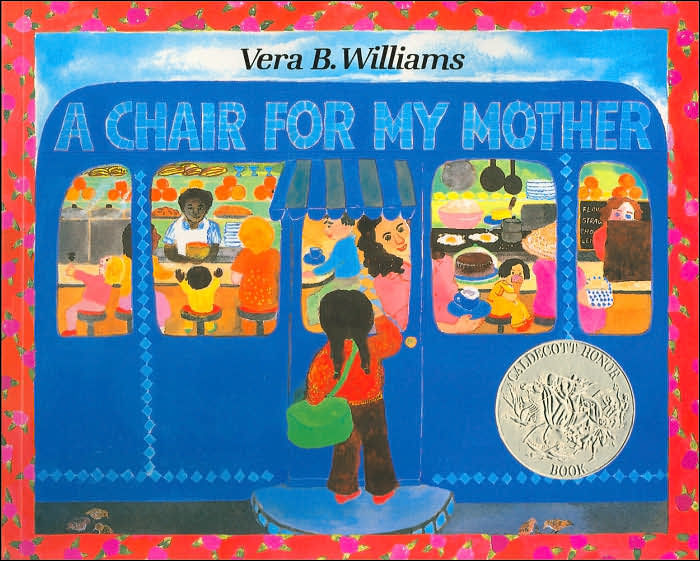 Finally, students have independently read A Chair for My Mother. This book definitely falls on my favorite books list, and it might fall pretty close to the top. It’s about a girl whose family has to rebuild their life after their home burns down in a fire. It may sound unsettling from my quick summary, but it is a genuinely heartwarming text. (Another favorite from my childhood. Who reading this was a Reading Rainbow child growing up? Butterfly in the sky…) This is our “assessment” text, meaning that students are writing their own short-answer responses about the narrative elements in this text. I’ve given you a link to the book above, but as I’m using this as an assessment tool, I appreciate your willingness to let your students work through the story themselves, without benefitting from your expert interpretation of the text. I’ll let you know once we’re done using this text (probably close to conferences), and you’ll be free to enjoy it as a family (though I fear that your fourth grader might be tired of it by then).
Finally, students have independently read A Chair for My Mother. This book definitely falls on my favorite books list, and it might fall pretty close to the top. It’s about a girl whose family has to rebuild their life after their home burns down in a fire. It may sound unsettling from my quick summary, but it is a genuinely heartwarming text. (Another favorite from my childhood. Who reading this was a Reading Rainbow child growing up? Butterfly in the sky…) This is our “assessment” text, meaning that students are writing their own short-answer responses about the narrative elements in this text. I’ve given you a link to the book above, but as I’m using this as an assessment tool, I appreciate your willingness to let your students work through the story themselves, without benefitting from your expert interpretation of the text. I’ll let you know once we’re done using this text (probably close to conferences), and you’ll be free to enjoy it as a family (though I fear that your fourth grader might be tired of it by then).
Coming soon: Updates on math, science, social studies, and targeted instruction!
Posted in Class Updates|By Jon Moss
September 14, 2017
Rounding Numbers (Help with Homework)
Today was rounding day! Students spent a lot of time working on this challenging skill. We started working on rounding numbers yesterday, and today’s focus was rounding numbers to different place values. For example, 24,829 can be rounded to the nearest ten-thousand (20,000), the nearest thousand (25,000), the nearest hundred (24,900), or the nearest ten (24,830). It took a lot of hard work for students to begin to feel comfortable with how to round to different places. So while they worked on their worksheet (which they’re finishing for homework), I made this video to help them (and parents) tonight! Enjoy!
Posted in Class Updates|By Jon Moss
September 8, 2017
Curriculum Night 2017
Thank you to call the families who joined us yesterday for curriculum night! If you weren’t able to join us, or if you want to relive all the fun, here’s a recording of the session. As always, please feel free to email me with any questions you may have!
Posted in Class Updates|By Jon Moss
September 6, 2017
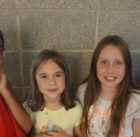
Reminder: Curriculum Night TOMORROW!
Remember, curriculum night is tomorrow evening! At 6:00pm, Miss Kaela Crystal is holding a meeting for families interested in learning about the strings program. (Anyone who plans of having their fourth grader participate in the string orchestra is STRONGLY encouraged to attend.) At 6:30pm, you’re invited to join me here in room 209 to learn all about fourth grade. It’s sure to be an amazing evening! 😉 Hope to see you here!
Posted in Class Updates|By Jon Moss
September 6, 2017
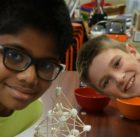
One Week In!
Hello, families! It’s hard to believe that it was only a week ago that we first came together to start the school year. We’ve been working on so many different activities, learning classroom routines and expectations, and getting to know one another. I’ve enjoyed the past week, and I hope your fourth grader has too! Here are a few highlights:
 On the first day, we came together as a school to ring the school bell and to ring in a new year! We also did some getting to know you activities, including beginning the “Spiral Me” posters, which we’ll HOPEFULLY have ready to share tomorrow night at curriculum night! (Remember! See you at 6:30pm!)
On the first day, we came together as a school to ring the school bell and to ring in a new year! We also did some getting to know you activities, including beginning the “Spiral Me” posters, which we’ll HOPEFULLY have ready to share tomorrow night at curriculum night! (Remember! See you at 6:30pm!)- Our second day of school was filled with quite a bit of procedural discussions. How does morning arrival work? What are our dismissal routines? What should a safe and fun recess look like, sound like, and feel like? These were all topics on Tuesday. It’s not glamorous, but it does help us ALL down the road by making sure that expectations are clear and understood by all. We also opened up the class library by discussing the routines (Yes, more routines!) for shopping for, borrowing, and returning books.
 Friday opened with a terrific discussion about what fairness means in our class. Students shared their own ideas, and we settled on our class definition. (You can see it tomorrow at at curriculum night! 6:30pm!) We also met with Mr. G to discuss expectations for town meetings. But a fun highlight was getting to work in groups to design some REALLY COOL structures out of marshmallows and toothpicks! I was amazed both my the creativity as well as the collaboration I saw.
Friday opened with a terrific discussion about what fairness means in our class. Students shared their own ideas, and we settled on our class definition. (You can see it tomorrow at at curriculum night! 6:30pm!) We also met with Mr. G to discuss expectations for town meetings. But a fun highlight was getting to work in groups to design some REALLY COOL structures out of marshmallows and toothpicks! I was amazed both my the creativity as well as the collaboration I saw.- Yesterday, we started working on our social contract (more on this another time) and we continued working on our Spiral Me projects. We met again as a grade to discuss lunchroom expectations and to touch base on some school safety routines.
- Today was, I feel, the first day in which we started some normal routines. We launched math with a great conversation about how we FEEL about math. It’s something students tend to love or loathe, and we opened with me sharing my story as a math student. I really struggled with math growing up, and I felt as if I wasn’t a “math person”. But we talked a lot about how wrong I was, how much I grew to enjoy math (though not until college, sadly), and how recent scientific research has disproven the idea of some people being more mathematically inclined. Our conversation surrounded the ideas within this video:
Our math lesson continued with an introduction to place value. Some students felt more comfortable with the concepts than others, and that’s TOTALLY FINE. It’s day one of math, after all! As adults, we don’t all master a new concept at the same rate, so we surely can’t expect our kids to either. We’ll keep working together, and at curriculum night tomorrow (6:30!) I’ll share more information about how you can help your fourth grader at home.
Did I mention that we have curriculum night tomorrow at 6:30? 🙂 I’d love to meet you! Remember, Miss Crystal is holding a meeting for families interested in the strings program tomorrow at 6pm.
Posted in Class Updates|By Jon Moss
August 30, 2017
Family Surveys for the New School Year
Hello, families! Our first day is off to a terrific start, and I’m excited to get to know your kids better. Would you please take a few moments to complete TWO surveys for me? These help me to better target instruction to meet your child’s needs and to best address your goals. The first survey is a general survey that helps me to learn about your child. The second survey focuses on technology and will help me to understand more about your child’s access to and comfort with different forms of technology. Thank you for completing these at your earliest convenience. (I’d love to have them by Friday, if possible.) If you prefer to complete them on paper, please email me or send in a note, and I’ll print them for you.) The surveys are embedded below this paragraph. You do not need to complete both of them at once.
Posted in Class Updates|By Jon Moss
August 13, 2017
Welcome to Room 209!
 Hello! Welcome to the online home of PGS Room 209. During the school year, I will update this web site regularly with information about activities happening in Room 209, bulletins and news items, current events related to what we’re studying in social studies, online assignments, and much more.
Hello! Welcome to the online home of PGS Room 209. During the school year, I will update this web site regularly with information about activities happening in Room 209, bulletins and news items, current events related to what we’re studying in social studies, online assignments, and much more.
It’s going to be a great year in fourth grade. There are so many new things to learn, and there are some really interesting activities coming up! Remember, I’m hosting a meet & greet on Tuesday, August 29th, at 3:00pm.
About Me
I asked my son (who is starting second grade) what I should tell you about myself. Here’s his report:
- I have two kids: Charlie and Caroline.
- I like to play Word Blocks on my phone.
- I love our dog, Rimley.
- I don’t like shows that imitate Paw Patrol. (The real Paw Patrol is the best! Puppy Dog Pals is a copy!)
- I like to go biking on the Rails to Trails path.
- I enjoy going on vacation to Atlantic City (my birthplace).
- I love to cook dinner.
- I really don’t like the movie Happy Feet.
Caroline (age 4) would also like you to know that I like to be silly with her and Charlie.
I live locally with my wife, my son (Charlie), our daughter (Caroline), and our dog (Rimley). In my spare time, I like working on home improvement projects, making things in my woodworking shop, especially using my new lathe, finding “good eats” at local farmers’ markets, or just relaxing by cooking, listening to old time radio shows from the 1940s and 50s, reading comic books, or watching the news. I collect old reel to-reel tapes of music, antique or unusual telephones, submarine paraphernalia, and all things related to Star Trek. This summer, I spent a lot of time working at a local summer camp, setting up my classroom, and traveling with my family.
I enjoy tinkering with my computer and coming up with interesting ways in which I can use technology in the classroom. (You can definitely expect to use computers a lot in Room 209! I enjoy using Chromebooks, our class’ SMART Board, and other technologies while teaching.) Of course, I also love cheering on my favorite sports teams, the Boston Red Sox (Don’t worry Yankees fans, I promise not to be mean!) and the New Britain Bees!
Click “more” to learn more about me and fourth grade!
Posted in Class Updates|By Jon Moss

